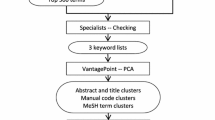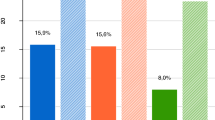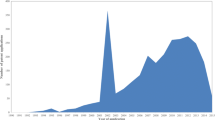Abstract
In this study, we combine the specialization scores for publications and patents (the latter is a new indicator of cross-disciplinary engagement) to achieve more comprehensive navigation of the innovation trajectory of a technology. The patent specialization score draws upon counterpart research publication indicator concepts to measure patent diversity. Two nano-based technologies—Nano-enabled drug delivery (NEDD) and Graphene—provide contrasting explorations of the behavior of this indicator, alongside research publication indicators. Results show distinctive patterns of the two technologies and for the respective publication and patent indicators. NEDD research, as evidenced by publication and citation patterns, engages highly diverse research fields. In contrast, NEDD development, as reflected in patent International Patent Classifications (IPCs), concentrates on relatively closely associated fields. Graphene presents the opposite picture, with closely linked disciplines contributing to research, but much more diverse fields of application for its patents. We suggest that analyzing the field diversity of research publications and patents together, employing both specialization scores, can offer fruitful insights into innovation trajectories. Such information can contribute to technology and innovation management and policy for such emerging technologies.


Similar content being viewed by others
Notes
This study analyzes the publication records by the “publication year” rather than “submitted year”. To align the time with the publications, we use the publication year of patents rather than the application year.
Our research uses T-IPCs rather than original IPCs in order to address the IPC population problem without manipulating the actual meaning of the categories. Thus, we can consider the T-IPCs as the aggregated level IPCs that still contain information about the technology field or application area where the patent invention can be used.
References
Albert, M., Avery, D., Narin, F., & McAllister, P. (1991). Direct validation of citation counts as indicators of industrially important patents. Research Policy, 20(3), 251–259.
Almeida, P., & Kogut, B. (1997). The exploration of technological diversity and geographic localization in innovation: Start-up firms in the semiconductor industry. Small Business Economics, 9(1), 21–31.
Breschi, S., Lissoni, F., & Maler, F. (2003). Knowledge-relatedness in firm technological diversification. Research Policy, 32(1), 69–87.
Carley, S., & Porter, A. L. (2012). A forward diversity index. Scientometrics, 90(2), 407–427.
Chavarro, D., Tang, P., & Rafols, I. (2014). Interdisciplinarity and research on local issues: Evidence from a developing country. Research Evaluation, 23(3), 195–209.
Dahlin, K. B., & Behrens, D. M. (2005). When is an invention really radical?: Defining and measuring technological radicalness. Research Policy, 34(5), 717–737.
Danneels, E. (2007). The process of technological competence leveraging. Strategic Management Journal, 28(5), 511–533.
Galunic, D. C., & Rodan, S. (1998). Resource recombinations in the firm: knowledge structures and the potential for schumpeterian innovation. Strategic Management Journal, 19(12), 1193–1201.
Glänzel, W., Schubert, A., & Czerwon, H.-J. (1999). An item-by-item subject classification of papers published in multidisciplinary and general journals using reference analysis. Scientometrics, 44(3), 427–439.
Gruber, M., MacMillan, I. C., & Thompson, J. D. (2008). Look before you leap: Market opportunity identification in emerging technology firms. Management Science, 54(9), 1652–1665.
Hall, B. H., Jaffe, A., & Trajtenberg, M. (2005). Market value and patent citations. The Rand Journal of Economics, 36(1), 16–38.
Hinze, S., Reiss, T., & Schmoch, U. (1997). Statistical analysis on the distance between fields of technology. FhG-ISI: ISE Working Paper.
Jaffe, A. (1986). Technological opportunity and spillovers of R & D: Evidence from firms’ patents, profits, and market value. The American Economic Review, 76(5), 984–1001.
Jaffe, A. B. (1989). Characterizing the “technological position” of firms, with application to quantifying technological opportunity and research spillovers. Research Policy, 18(2), 87–97.
Jaffe, A. B., Trajtenberg, M., & Hend, R. (1993). Geographic localization of knowledge spillovers as evidenced by patent citations. The Quarterly Journal of Economics, 108(3), 577–598.
Kay, L., Porter, A. L., Youtie, J., Rafols, I., & Newman, N. (2015). Mapping graphene science and development: Focused research with multiple application areas. Bulletin of the American Society for Information Science and Technology, 41(2), 22–25.
Kay, L., Youtie, J., Porter, A. L., Rafols, I., & Newman, N. (2014). Patent overlay mapping: Visualizing technological distance. Journal of the Association for Information Science and Technology, 65(12), 2432–2443.
Leydesdorff, L., Alkemade, F., Heimeriks, G., & Hoekstra, R. (2015). Patents as instruments for exploring innovation dynamics: geographic and technological perspectives on “photovoltaic cells”. Scientometrics, 102(1), 629–651.
Leydesdorff, L., Carley, S., & Rafols, I. (2013). Global maps of science based on the new Web-of-Science categories. Scientometrics, 94(2), 589–593.
Leydesdorff, L., & Rafols, I. (2009). A global map of science based on the ISI subject categories. Journal of the American Society for Information Science and Technology, 60(2), 348–362.
Morillo, F., Bordons, M., & Gómez, I. (2003). Interdisciplinarity in science: A tentative typology of disciplines and research areas. Journal of the American Society for Information Science and Technology, 54(13), 1237–1249.
Moya-Anegón, F., Vargas-Quesada, B., Chinchilla-Rodrígu, Z., Corera-Álvarez, E., Munoz-Fernánde, F., & Herrero-Solana, V. (2007). Visualizing the marrow of science. Journal of the American Society for Information Science and Technology, 58(14), 2167–2179.
Moya-Anegón, F., Vargas-Quesada, B., Herrero-Solana, V., Chinchilla-Rodríguez, Z., Corera-Álvarez, E., & Munoz-Fernández, F. (2004). A new technique for building maps of large scientific domains based on the cocitation of classes and categories. Scientometrics, 61(1), 129–145.
Nagaoka, S., Motohashi, K., & Goto, A. (2010). Patent statistics as an innovation indicator. In B. H. Hall & N. Rosenberg (Eds.), Handbook of the Economics of Innovation (pp. 1083–1127). Oxford, UK: Elsevier.
Organization for Economic Cooperation and Development. (2015). OECD Library. Retrieved May 13 from OECD.Stat: https://stats.oecd.org/Index.aspx?DataSetCode=PATS_IPC.
Porter, A. L., & Rafols, I. (2009). Is science becoming more interdisciplinary? Measuring and mapping six research fields over time. Scientometrics, 81(3), 719–745.
Porter, A. L., Roessner, D. J., & Heberger, A. (2008). How interdisciplinary is a given body of research? Research Evaluation, 17(4), 273–282.
Rafols, I. (2014). Knowledge integration and diffusion: Measures and mapping of diversity and coherence. In Y. Ding, R. Rousseau, & D. Wolfram (Eds.), Measuring scholarly Impact: Methods and Practice (1st ed., pp. 169–190). Switzerland: Springer International Publishing.
Rafols, I., Leydesdorff, L., O’Hare, A., Nightingale, P., & Stirling, A. (2012). How journal rankings can suppress interdisciplinary research: A comparison between Innovation Studies and Business and Management. Research Policy, 41(7), 1262–1282.
Rafols, I., Porter, A. L., & Leydesdorf, L. (2010). Science overlay maps: A new tool for research policy and library management. Journal of the American Society for Information Science and Technology, 61(9), 1871–1887.
Rao, R. (1982). Diversity: Its measurement, decomposition, apportionment and analysis. The Indian Journal of Statistics, 44(1), 1–22.
Rotolo, D., Hicks, D., & Martin, B. (2015). What Is an Emerging Technology? SPRU Working Paper Series.
Schankerman, M. (1998). How valuable is patent protection? Estimates by technology field. The Rand Journal of Economics, 29(1), 77–107.
Schmoch, U., Laville, F., Patel, P., & Frietsch, R. (2003). Linking Technology Areas to Industrial Sectors—Final Report to the European Commission. DG Research1. DG Research.
Segal, M. (2009). Selling graphene by the ton. Nature Nanotechnology, 4, 612–614.
Shapira, P., Youtie, J., & Arora, S. (2012). Early patterns of commercial activity in graphene. Journal of Nanoparticle Research, 14(4), 1–15.
Stirling, A. (2006). On the Economics and Analysis of Diversity. SPRU Electronic Working Papers Series No.28.
Stirling, A. (2007). A general framework for analysing diversity in science, technology and society. Journal Of The Royal Society, 4(15), 707–719.
Trajtenberg, M. (1990). A penny for your quotes: Patent citations and the value of innovations. The Rand Journal of Economics, 21(1), 172–187.
Zhou, X., Porter, A. L., Robinson, D. K., Shim, M. S., & Guo, Y. (2014). Nano-enabled drug delivery: A research profile. Nanomedicine, 10(5), 889–896.
Acknowledgments
We acknowledge support from the US National Science Foundation under Award #1064146—“Revealing Innovation Pathways: Hybrid Science Maps for Technology Assessment and Foresight” and Award # 0937591—the Center for Nanotechnology in Society at Arizona State University. The findings and observations contained in this paper are those of the authors and do not necessarily reflect the views of the National Science Foundation.
Author information
Authors and Affiliations
Corresponding author
Rights and permissions
About this article
Cite this article
Kwon, S., Porter, A. & Youtie, J. Navigating the innovation trajectories of technology by combining specialization score analyses for publications and patents: graphene and nano-enabled drug delivery. Scientometrics 106, 1057–1071 (2016). https://doi.org/10.1007/s11192-015-1826-9
Received:
Published:
Issue Date:
DOI: https://doi.org/10.1007/s11192-015-1826-9




